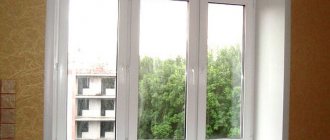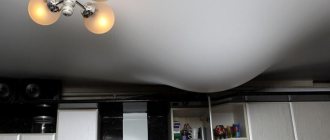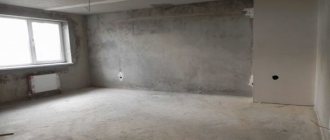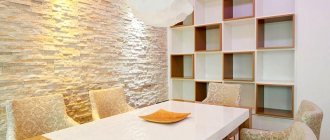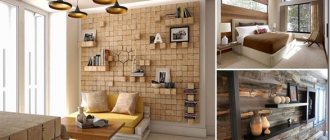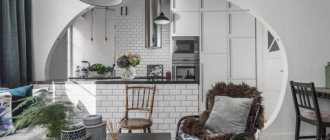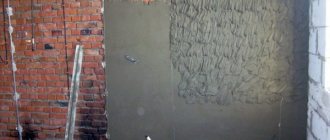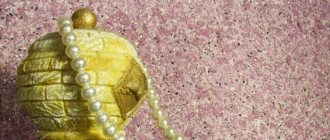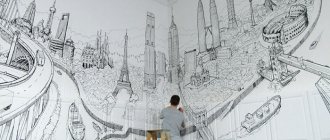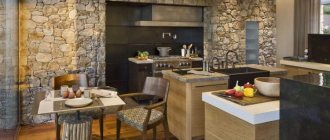17484 0 2
Felix June 16, 2017 Specialization: philological education. 20 years of experience as a builder. Of these, for the last 15 years he led a team as a foreman. I know everything about construction - from design and zero cycle to interior design. Hobbies: Vocals, psychology, quail breeding.
Decorative strips distinguish between two types of wallpaper.
Greetings, my dear readers!
Molding - not a single renovation can be done without this applied decor in the form of strips. You need to know how to use it correctly. I'll tell you about this.
Molding is used in rooms to zone them or give some part of them relief or additional volume. When decorating walls, floors and ceilings, they can be separated from each other by facing materials.
Decorating walls with wallpaper and moldings in an apartment with your own hands
The use of moldings for interior design is popular. Moldings on the walls allow you to make the interior more interesting; in addition, with the help of them, the defects of the wall are hidden, and you can visually make the room more correct. This is a great option to get rid of errors in the architecture of the room. How you can transform a room using moldings on the walls in the interior will be discussed in the article.
Moldings in various interior styles
Moldings for finishing certain surfaces of residential premises are used in a wide variety of interior design styles.
Types of molding reliefs that are great for Mediterranean and antique styles.
Most relief strips and shaped decorative elements are suitable for almost all interior styles, but for some of them you have to choose a specific version of volumetric patterns.
"Baroque"
The Baroque style is replete with moldings and decorative details with embossed plant patterns. One could even argue that it is they who create the general mood of such interior design.
The Baroque style is suitable for decorating living rooms, bedrooms, and dining rooms. Often used in private houses built in the same style.
Previously, these stucco elements decorating the ceiling and walls were made from gypsum, and it can safely be called a traditional material for their manufacture. Today, in specialized stores you can choose moldings with various volumetric reliefs made from lighter materials, which are much simpler and more convenient to install. In addition, they can be easily tinted in any color.
In this style, light colors predominate, so the surfaces are decorated with white or gilded “stucco”.
To decorate the ceiling surface, a whole complex of moldings is used, consisting of straight strips and elements with various shapes and relief patterns. In the Baroque style, these details are placed on the ceiling symmetrically relative to the center of the surface, which, in turn, is decorated with a decorative rosette for a chandelier.
In the Baroque style, in addition to linear moldings, a decorative rosette for a chandelier necessarily suggests itself, strictly in the center of the ceiling surface
On the walls, with the help of molding strips, unique panels of different perimeter are formed, which are painted or covered with wallpaper of the same or different color from the main surface, but in good harmony with the overall background. In this case, moldings serve as framing elements that help maintain the interior style. Furniture, flooring, as well as draperies - curtains on windows or niches - should also match the design of the walls.
"Provence"
A popular style for decorating rooms in modern houses and apartments is “Provence”. Inspired by the warm influences of southern France, this style provides a cozy environment conducive to rest and relaxation.
Moldings are not a mandatory element of finishing in the Provence style, however, they are used here too
It is very convenient that this style allows the use of creative improvisation in the design, since it is not particularly limited in the use of certain elements. In the Provence style, simple-shaped moldings with simple geometric reliefs are used, and painted in colors that are in harmony with the basic tones of the room design. In the decoration of this style, framing elements can be fixed at the junctions of the surfaces of walls and floors, as well as walls and ceilings - this is the same case when they are otherwise called floor and ceiling plinths.
To decorate the main area of walls in the Provence style, moldings are used less frequently. However, sometimes simple versions of planks are still used to frame mirrors, window and door openings, as well as to set the height limit of the lower, “panel” part of the walls
Another technique used in this style solution is a combination of moldings that are different in width, shape, and color. A decorative fireplace in the Provence style would also be appropriate, but only one assembled from molding elements with simple relief shapes.
In the Provence style, even on the ceiling rosette for a chandelier, “pretentiousness” is not welcome - everything is much simpler
Ceiling rosettes for a chandelier in the Provence style are distinguished by their simplicity of relief and do not have complex floral or geometric volumetric patterns.
Classic style
Another favorite option for decorating apartments, especially those located in old houses with arched windows and high ceilings, is the classic style. Thanks to the presence of similar architectural forms, this direction suggests itself for decorating such rooms. In some cases, the owners of newly built private houses deliberately choose an architectural project made in this style, and then decorate the interiors accordingly.
Prices for wallpaper for painting
wallpaper for painting
The classic style always involves arched structures, which will require either curly or flexible moldings
Typically, furniture used in classic decoration is made of natural dark or tinted wood and has carved frames of various configurations. Using the same principle, it is advisable to select the reliefs of moldings used for finishing walls, arches of windows and doors.
Scandinavian style
The Scandinavian version of the design of living rooms is also not forgotten in interior design, and it is used in various variations. Basically, this approach uses modern furniture accessories with strict lines and geometric shapes, but they are smoothed out by numerous pillows, soft blankets placed on sofas and small floor carpets with piles of different lengths.
Moldings in the Scandinavian design style emphasize the distinctly neat lines of the interior decoration
Moldings in this style of room decoration are suitable for framing arches, windows, ceilings and floors. Here, such decorative elements are not the main details - they are used as auxiliary ones and emphasizing the evenness of the walls and the neatness of the interior. If the design is done in light colors, then white moldings are matched to it. If other shades are used for painting or gluing surfaces, a light frame can also be chosen, or the moldings can be painted in tones close to the main colors of the overall design of the room.
Mediterranean style
The Mediterranean style of room design assumes the presence of wide doors or large windows, behind which a spatial perspective opens up with the sea water surface. It is clear that not all apartments have windows or balconies overlooking the sea, lake or simply a beautiful corner of exotic nature. Therefore, when recreating this style, they often use appropriate painting on plaster or high-quality photo wallpaper.
Using a Mediterranean style to decorate a room, it is possible to visually lengthen or expand it.
In this interior design style of rooms, moldings are used in all sorts of ways - this is a clear highlighting of the panel part on the walls, framing arches and doorways, the ceiling, as well as the obligatory section of the wall with paintings or photo wallpaper. Molding strips are fixed around the wall images and columns or semi-columns are installed as a continuation of the arcade pattern, simulating an exit to a balcony or street. This design of the room visually expands its space due to the perspective of the image and the installation of external decorative elements next to it.
Using decorative moldings on the walls of a Mediterranean-style room
If the room already has a large window, a completely glass door, or a picturesque image is applied to the wall, but you would like to complement the interior with elements that enhance the direction of the style, you can use appropriate furniture, accessories and finishing materials. For example, narrow small sofas with straight backs are suitable for this style, the role of which can be played by a wall decorated with moldings, near which this seating area is installed. Natural mats are used as carpets, and curtain draperies and furniture covers are made from linen or cotton fabrics.
Mediterranean style involves light or pastel colors, as well as freedom and lightness of space. It would be useful to place a flowerpot with some exotic plant in the room.
Romantic style
The romantic style is great for decorating a bedroom, as it uses pastel, non-aggressive colors that will have a positive effect on a person’s psyche and his mood - pale pink, light green, blue, etc.
Neat white moldings look great on delicate tones of decoration in a romantic style
These shades will go well with the white color of the moldings framing the walls and furniture accessories. In this style, it is acceptable to use molding strips of any shape and width, emphasizing the lines of the interior elements. Other decorative elements are also acceptable, but without much “pretentiousness”. They are mounted on walls, ceilings, built-in cabinets, niches and arches, and in some cases it would be useful to install one or two columns or semi-columns in the interior.
Dining room in a romantic style - white moldings on a soft lilac wall surface that is pleasing to the eye
The romantic direction can also be used in decorating the dining room. However, here you need to remember that if the room is very small, then you should not use too many moldings installed in the form of frames and panels on the walls, since such details will visually make the room smaller. If the ceiling is not too high, then it is undesirable to fix the ceiling plinth at the junction of the walls and ceiling, but it is better to place it on the ceiling surface itself. If the ceiling is too high, it is recommended to fix the molding on the wall, below the line where the two planes meet - this technique will make the room more comfortable and compact.
English style
In the English interior style, moldings with clear geometric reliefs are used. Moreover, they can be used on any part of the wall or built-in piece of furniture, sometimes even completely covering their surface.
English style always presupposes the presence of a fireplace, for the decoration of which you cannot do without moldings
A mandatory attribute of the English style is a real fireplace. Since it is often impossible to install such luxury in an apartment, it is replaced with a decorative or electrical option. But the main thing for decorating the hearth is considered to be a portal constructed from one or another type of molding with a simple relief.
The English style is traditional with numerous built-in open cabinets filled with decorative accessories. The mantelpiece is most often decorated with a table clock and a pair of candlesticks.
The English version of the design does not involve numerous ceiling decorative elements, except for the molding-plinth framing its perimeter. However, sometimes a few details are still fixed on the ceiling surface in the corners - corners that should have clear, multi-stage relief shapes.
American style
The American style has also become popular for decorating Russian homes, as practicality and lack of frills prevail in it. The decorative effect of the room is achieved through the correct selection of materials that are in harmony with each other in color and shape.
Molding dividing the walls into two zones, in a fairly laconic finish, made in the American style
In this style, moldings are used, so to speak, very “dosed”, that is, only in those areas where they are really needed. Typically this is a division of the wall into an upper decorative space and a lower, darker panel area, approximately at the level of the door handle. Floor skirting boards almost always have a height of at least 150 mm, which helps to avoid damage to the panel material. Wall or ceiling molding helps to visually reduce or increase the height of the ceiling, depending on their fastening and the degree of need to create such an effect.
In the American style, there are no columns on the walls, and the ceiling has “stucco” with complex floral patterns. However, just like in the English style, the living room can be decorated with a decorative or functioning fireplace.
So, in any popular interior style there is a place to place molding. However, taking into account style directions, strictly defined configurations of these decorative elements, their number and areas of installation are selected. There should be moderation in everything: excessive use of moldings or details that do not match the style is even a less desirable solution than their complete absence in the interior.
At the end of the publication, there is an interesting video collection showing many options for using moldings in interior decoration of various styles.
What is molding
Molding is a decorative overlay strip with a three-dimensional configuration
, with which you can create interesting interior solutions in different architectural styles.
With its help, you can frame windows and doors, separate different types of external covering from one another, highlight decorative items, make wallpaper inserts and much more.
This design element goes well with all kinds of finishing materials - plaster, paint, panels, wallpaper.
Wall molding is a long strip starting at 2 m in length. Its width can vary from 1 to 10 cm or more. These decorative strips can be flat or made in the form of a baguette - beveled at an angle, convex and carved.
To decorate the composition, small decorative details are also used, connecting the wall moldings into a single composition. For example, corners of different configurations, decorated with a special pattern, curved and soft parts for decorating arches, and much more.
Application of molding
The photo shows an applied decor, to which the concept of “molding” applies.
Molding is a broad concept that includes baguette, baseboards, stucco molding, trim, all kinds of frames, photo and painting frames. There are many types of this decor. They differ in material, size, shape, style, relief and design.
Decorative strips go well with paint. They can be mounted on a wall with wallpaper or decorative plaster.
Plank decor gives the room a finished look.
Molding is a good way to enliven and diversify the interior of a room without unnecessary effort. By using it correctly, you will improve the aesthetic qualities of the room, giving it style and sophistication.
Purpose of decorative strips
| Image | Purpose of the molding |
| Separation of surfaces. This function is performed by skirting boards installed between the walls and the floor. Baguettes and fillets separate the corners of the walls. Molding can separate two types of finishing materials, including wallpaper. Ceiling skirting boards separate the ceiling from the walls. | |
| Framing room and interior elements. This task is performed by the platbands bordering doors and windows. Paintings, photographs and mirrors are decorated with frames. Often, rectangular maps on the wall are created from molding. They draw attention to interior elements - mirrors, lamps, paintings, etc. | |
| Relief creation . Decor, which serves to give volume and relief to the ceiling or walls, is installed on large areas of their surface. This molding is called a medallion or panel. | |
| Masking of defects. Decorative strips can be used to mask gaps and cracks in the cladding, finishing joints, technological holes, etc. | |
| Visualization. With the help of molding you can visually narrow and expand the space, as well as zone rooms. |
Features of installation of moldings
Since the molding is intended to decorate the room, it is important to install it carefully, without leaving marks on the surface.
What to glue
Before gluing moldings to the wall, you need to decide on the glue. It all depends on the weight of the bar and the material from which it is made.
Molding adhesive
For the installation of lightweight polyurethane and foam elements, PVA or wallpaper glue is suitable. You can also purchase special mounting adhesive for decorative polyurethane products.
More effort will have to be made when installing wooden decorations. They are fastened with self-tapping screws or nails, in addition, it will be necessary to mask the marks from the fastening.
Gypsum products are glued only with gypsum mortar or polyurethane glue, as they are heavy.
Don't rush to start working on the molding. First, let him “get used” to the room for about a day. Then it will not be deformed and will stick securely to the wall.
How to glue
Before attaching the molding to the wall, it must be carefully prepared: leveled, cleaned and dried.
The process of gluing molding to the wall
Here it is necessary to take into account two nuances:
- you can glue the moldings directly to the wall, it’s more reliable, but you’ll have to adjust the wallpaper to match them;
- It is easier to glue onto wallpaper, plus you can hide surface imperfections.
Wallpaper moldings are often chosen from polystyrene or polyurethane, since they are much lighter in weight and look better on papered walls.
You should start attaching the moldings with markings. You can use the cornice itself for this.
Then you need to cut them. Using a miter box it is easy to make oblique cuts.
The corner joints are glued first. If you decide to glue on a bare wall, do not forget to moisten it with water or primer.
Apply glue evenly to the plank and press it against the wall until it sets.
Docking of products requires special attention. It would be good to use joint glue for coating. It is applied generously so that after pressing, the excess is squeezed out.
After a day, you can start painting the molding.
Types of moldings
Manufacturers make several different types of moldings for gluing on the surface of walls and ceilings. Each of the subspecies has individual characteristics and features.
To make your choice, we suggest that you familiarize yourself with the most popular decorative elements. The categories of linings presented below are especially popular in Moscow.
Polyurethane moldings
The most common are decorative profiles made from polyurethane. This finish represents an ideal balance between price and quality of the product.
Among its advantages it is worth identifying:
- high strength;
- long service life exceeding thirty years.
This wall molding can be easily wiped with an ordinary dry cloth. It is also quite easy to glue: you need special glue for a profile made of polyurethane. Polyurethane overlays are made in different colors, so they most often do not require further painting.
Plastic moldings
Wall molding made of plastic is one of the most optimal types of linings in terms of price and quality. Main advantages:
- Ease. The weight of the material is extremely light, which eliminates the need to use special equipment for installing products;
- Water resistance. Available for use in rooms with high moisture levels;
- Price. Plastic is an affordable consumable material with a wide range of properties, and therefore has a low cost and a huge scope of application;
- Quick installation. Installing plastic strips is not difficult. By following the instructions, even a beginner in the repair industry can handle gluing the plastic overlay.
In addition, PVC plastic linings are resistant to the negative effects of environmental factors. These products are an excellent option for those who want to quickly and inexpensively add a “zest” to their home interior.
Metal decorative moldings
Available in bronze, gold or silver styles. They are used mainly in classic interiors of apartments and hotels and allow you to create a truly chic, expensive design.
Not the most popular models due to the fact that finishing with stylized overlays imitating precious metal requires the design of a suitable interior. In other words, a room decorated with these products literally looks like a king.
Therefore, the wall covering must be appropriate - cheap wallpaper is excluded. Such products are also used to decorate mirrors and fireplaces.
Wood overlays
Wooden wall molding is considered less popular. Decorative strips for wall surfaces are sold at a relatively high cost due to the high cost of the wood base.
But the price is completely justified. After all, this material is environmentally friendly and has an expensive, attractive appearance.
The wood profiles are fastened using self-tapping screws due to the fact that the linings are quite heavy. When installing planks in rooms with high humidity levels, they must be coated with a special varnish and antiseptic for protective purposes.
From foam plastic
Foam wall molding is also a light weight plank. It costs very little and can be mounted quite quickly on the desired surface.
The advantage of polystyrene foam linings is their resistance to moisture, and therefore they are often used to decorate bathrooms. The products do an excellent job of hiding defects on wall surfaces.
Wall and ceiling moldings made of gypsum
Plaster models attract attention due to their luxurious appearance, but they also cost a lot. Installation of gypsum cornices should only be carried out by experienced specialists.
Gypsum is a renewable material. It can be restored after the product no longer looks its best. Suitable for both installation on walls and ceilings.
What kind of glue is needed?
Different adhesives are used to attach different materials. Its main task is to increase or create the possibility of adhesion between two materials of different nature. Accordingly, for strips made of rubber and wood, different adhesives are required and they must be selected correctly.
What glue should I use to glue moldings?
- Liquid nails are a universal option. With its help, all strips made of polymers are secured - plastics, polyurethane, rubber and even wood. It is also suitable for rare cases when the plinth is made of ceramic or even artificial stone. With its help you can glue moldings on cars.
- LoctitePL 355 is a professional solvent-free compound. It is odorless and quite suitable for any interior work. A distinctive feature is resistance to frost.
- Decomaster 250 - designed for attaching decorative parts specifically, is colorless and odorless, dries within a day. Very resistant to moisture and temperature changes: withstands 5 cycles of complete freezing and thawing.
- Bison EXPERT – used for fixing planks of any kind on absorbent and non-absorbent surfaces.
Adhesive for moldings: which one to choose?
Glue for moldings must be selected based on what material served as the basis for the manufacture of the product. So, for wood models you will need to use special adhesives designed for working with wood. Plastic variations should be glued with plastic glue, and foam plastic with any universal glue.
It is also important to focus on the weight of the material - the heavier the pad, the stronger and better quality the glue it will require. In general, some manufacturers make adhesives for different types of moldings, so it would be more advisable to use a specially designed adhesive instead of a universal compound.
What to glue on
Depending on what the cornices are made of, choose an adhesive solution.
Lightweight polyurethane strips and foam blanks are held on by PVA and wallpaper glue. Polyurethane glue can be used.
Gypsum is glued to a gypsum mixture or polyurethane adhesive solution.
Due to its heavy weight, the tree is fixed with self-tapping screws.
How to choose glue
Among the possible proposals, it is necessary to consider compositions for interior work with the selected material.
Loctite PL mortar from a German manufacturer for interior finishing, gluing surfaces with skirting boards and decor. The product reliably glues parts made of MDF, chipboard, foam plastic, PVC, gypsum board, cork. Suitable for wet rooms, no solvents in the composition, no unpleasant odor.
The composition of Decomaster 250 adhesive was created specifically for gluing moldings. The substance looks like a milky white liquid. Coated surfaces set in 10 minutes, complete drying takes a day.
Molding adhesive
High adhesive strength and resistance to air humidity are observed. In case of severe frosts, there is no need to worry - the mixture can withstand up to 5 defrosting cycles.
Stayer Professional - assembly adhesive for construction and repair work from a German manufacturer. It is characterized by a high degree of fixation, resistance to moisture, temperature changes, and frost.
The composition is suitable for working with moldings, PVC, panels, borders, glass.
Kraft Nails Premium KN-604 installation adhesive for working with lightweight parts, such as ceramics, panels, ceiling cornices.
The absence of solvents, strong aromas, and toxicity makes it safe. The substance is resistant to temperature changes and dries quickly.
Domestic version Zubr Expert for interior decoration and fastening of building materials. Suitable for installation of moldings, corners, stucco moldings. Can be used on absorbent or non-absorbent surfaces with uneven surfaces. The elastic substance does not contain toxic components, solvents, and tolerates frost.
Varieties
Molding is a three-dimensional relief strip that is attached to the surface of walls, ceilings, and around a door or window opening. The element has a length limit (2 m), but can be of different widths, shapes, and contents.
The materials used can be varied; the following types are most commonly used:
- polystyrene;
- plastic;
- polyurethane.
Decorative elements made from these materials are durable, easy to install and maintain. Rare cases require the use of overhead elements made of wood, natural stone, or plaster. This material is much more expensive, more difficult to work with, and requires careful care. Panels made of stone or wood are widely used in the restoration of historically significant objects, preserving authenticity as much as possible.
When using moldings made from natural materials in private houses and apartments, the complexity of maintenance must be taken into account. The materials are very whimsical and require certain environmental conditions. For example, wooden overhead elements quickly lose their shape, color, and other aesthetic qualities with high air humidity. Colored overlays and inserts in bright colors are gaining unprecedented popularity. They should be used more carefully; it is very easy to cross the line and the interior will take on an awkward look.
The concept of molding includes: stucco molding, baseboards, frames, strips, profiled panels. In cross-section, they can have a flat, carved or convex appearance. Can be equipped with many small molded decorative details. Even a ceiling frame that provides a smooth transition from the wall can be considered a molding. Colored moldings are used to focus attention on individual decorative details and to separate spaces with different textures.
Most often, the molding is simply attached to specialized glue or self-tapping screws, which are masked with putty. Fastening with self-tapping screws is used when the molding is made of heavy material or fastening by other means is impossible. The choice of molding depends on the overall style and decor of the interior. The interior style can be either classic or close to modern or urban.
Material of slats
Molding is made from different types of plastic, wood, metal or plaster.
Type 1. Wood
Wood has been used for centuries to make applied decor.
This is a traditional material for making moldings. Wooden decor must be treated with an antiseptic, and then it can be varnished or painted. Self-tapping screws or glue are used to secure the planks.
Advantages:
- Wood is easy to process.
- It is reliable and durable.
- The material is easy to paint and glue.
- The tree is durable with proper care.
- You can cut holes in the wooden molding for the wires.
Flaws:
- The tree is not moisture resistant.
- It's expensive.
- Wood planks have a large mass.
Type 2. Gypsum
Very often, rooms are decorated with plaster stucco.
This is another classic material for applied decor. To install such molding with your own hands, use gypsum or alabaster mortar.
Advantages of gypsum decor:
- A variety of shapes, colors, relief and patterns.
- Long service life.
Flaws:
- High price.
- Plaster decor is heavy.
- The material is fragile.
- Complex and expensive installation.
Type 3. Polyurethane
Polyurethane can be flexible, making it convenient to decorate curved surfaces with such decor.
Polyurethane strips are now the most popular. They can be rigid or flexible. Therefore, they can also be used to decorate curved surfaces.
Advantages of polyurethane molding:
- The material is smooth and lightweight.
- It is easy to varnish and paint.
- It’s easy to work with, stick to the base, including wallpaper.
- The service life of polyurethane planks is about 30 years.
- This molding is inexpensive.
- The material realistically imitates plaster stucco.
- It is easy to care for.
Type 4. Polystyrene
Polystyrene jewelry is very diverse.
Another plastic material for the production of molding is polystyrene.
Its advantages:
- The cuts on the planks are smooth and even, there are no defects or chips on them. This property is especially valuable when installing frames and frames that have complex shapes.
- The manufacturer's instructions indicate that polystyrene is easy to paint.
- This molding is easy to care for. It can be washed.
- Polystyrene weighs little and is inexpensive.
The disadvantage of the material is that it has a grainy surface.
Materials for decorative strips
Once upon a time, only plaster was used to make moldings. Today you can find products made from various materials on sale. Let us briefly describe the most popular options.
Polyurethane
Polyurethane baguettes are strong, lightweight and durable. They will last at least three decades, provided that they are properly cared for. Gluing them is easy, the plastic bends well and takes any desired shape. The surface of the polyurethane is smooth, dirt does not eat into it, and it is not difficult to wash it.
The material is resistant to dampness and temperature changes, it does not deform or darken. Therefore, it is used to decorate a bathroom or kitchen. Polyurethane products imitate gypsum stucco well. Available in different colors, if you can’t find the right shade, polyurethane can be painted.
Instagram tikkurila74
Instagram argomogilev
Polystyrene
Foam planks are attractive due to their variety of shapes and low cost. They are lightweight and moisture resistant. Dampness does not destroy them. But at the same time, polystyrene baguettes are very fragile and break easily. They must be handled very carefully, otherwise the surface will be damaged. Even pressing with your finger will leave dents on it. Difficulties may arise during the installation process. Foam plastic, unlike polyurethane, is not flexible, so it will not be possible to bend the product. Another important point: the choice of glue. Some of them dissolve polystyrene.
Gypsum
Gypsum baguettes are very beautiful and have a variety of relief shapes. They are strong and durable, last for decades and do not darken over time. Gypsum is quite resistant to mechanical damage; if necessary, a damaged part can be restored. A significant disadvantage of gypsum stucco is its heavy weight, which requires reinforced fastening. Also among the disadvantages are complex installation and high price. In addition, gypsum is hygroscopic. It absorbs moisture, which can accumulate inside the material and gradually destroy it.
Tree
Wooden strips-moldings are an expensive finish. They are environmentally friendly and beautiful, but rather difficult to care for. The tree is vulnerable to moisture and pathogenic microorganisms. Therefore, before installation and subsequently, treatment with an antiseptic and water-repellent compound is required. Still, it is better not to choose such decor for wet rooms. Heavy material is quite difficult to install. During the installation process, fastening with self-tapping screws is required.
- Decoration Materials
How to glue a foam ceiling plinth: detailed instructions
Step-by-step instructions
Whichever option for gluing decorative strips is chosen, it is recommended to follow simple rules:
- you need to start with rough markings;
- The moldings are pre-distributed to the required sizes by cutting with a hacksaw. The edges are treated with sandpaper;
- The corner joints are glued or secured first. Apply the glue liberally until the excess is squeezed out;
- The glued parts are pressed until they fully adhere to the surface.
Watch the video step by step:
To prevent the joints from spreading, you can use a stapler with staples. After the decorative moldings have dried, the staples are removed and the marks are masked with putty.
How to make molding with your own hands: instructions
Wall molding is often done independently, without the help of highly qualified craftsmen. There is nothing complicated about this: all that is required is a few tools and knowledge of a clear work algorithm.
Prepare the necessary equipment in advance so that it is at hand. Also mark the wall surface to prevent incorrect gluing: it will not be possible to remove the molding from the lined surface without leaving a trace. Therefore, make sure that everything is smooth and neat.
Preparing tools
It is simply impossible to make decorative wall molding without specially selected tools. Therefore, we will need to stock up on appropriate equipment.
So, we need:
- file for cutting baguettes;
- a miter box that will help cut the molding at the desired angle;
- construction glue gun;
- spatulas;
- sandpaper for rubbing away excess particles of the product.
Step-by-step work
First of all, you will need to measure the required length of the moldings and cut them according to the specified parameters. Using a miter box, cut the corners.
After this, we glue the corner parts in the corners and then install the even ones: follow the notes you made in advance.
If even after all the parts are glued, there are gaps, we recommend lubricating them with the same adhesive composition. It should take at least 24 hours for it to completely harden.
Wallpaper in molding on the wall: photos and picture framing
Molding is a universal accessory for decorating any room, be it a living room, bedroom, kitchen, bathroom or any other room. No matter what kind of apartment you have, large or small, molding will look great in any of them.
Moldings in the interior are a very fashionable and modern detail for interior decoration
Wallpaper in the molding on the wall, photos and paintings framed by it - all this looks more luxurious, sophisticated and elegant. You can also frame mirrors, wall paintings and other decorative elements with moldings.
If you choose the right molding, you can create a real work of art. If you handle it correctly, you can not only decorate the room, but also perform some functions, for example, visually expand or reduce the space of the room.
Moldings are made from different materials, such as:
- Gypsum;
- Styrofoam;
- Plastic;
- Tree;
- Marble;
- Polyurethane.
The most popular and inexpensive moldings are plastic or polyurethane. They are resistant to temperature changes and do not deteriorate in high humidity, so they can be used in the kitchen and bathroom. Plaster ones are very beautiful, and their color does not change for a long time; they are usually used to decorate ceilings and walls. But such moldings are very fragile and difficult to install. Wooden moldings can not only decorate rooms, but also protect them from various damages, since this material is very durable and strong. It is used for various types of decor; it will suit any interior: living room, hallway and bedroom.
Molding and wallpaper
Decorative strips separate wallpaper of different colors.
Moldings in the interior to separate wallpaper are used in two cases:
- Most often, they distinguish between panels made of different materials or from the same material, but of different texture or color.
Manufacturers are now producing special “companion” wallpapers. They are perfectly combined with each other in style, patterns and colors. By choosing them, you will get rid of the need to look for a suitable combination finish for you.
In a studio apartment, overhead decor is a must.
- Decorative slats are often used to separate wallpaper in studio apartments. They often need to delimit space in the bedroom, living room, kitchen, hallway.
How to glue planks to the wall?
The slats can be glued to the wallpaper, but they will have to be removed when changing the finish.
Professional builders have different opinions on whether it is possible to glue decorative strips directly onto the wallpaper or whether this should be done before finishing the walls. Here you can choose the option that is most suitable for you:
- In the first case, you will not need to adjust the wallpaper after installing the decor.
- With the second option, when you need to redo the cladding, you will not have to remove the strips.
Acrylic glue is suitable for all materials from which decor is made.
Before gluing the molding to the wallpaper, you will need to select the appropriate composition. Plastic strips of all types can be fixed with acrylic glue. Wooden decor, if you do not want to fasten it with self-tapping screws, can be glued with “liquid nails”.
Review of glue for working with moldings
For fixing moldins, stores offer a large selection of adhesive compositions. Here are some popular and well-proven adhesive options:
1. Loctite PL 355 – professional mounting adhesive made in Germany.
- moisture resistance,
- withstands frost down to -20C,
- does not have an unpleasant odor,
- does not contain solvents,
- glues securely and quickly.
Suitable for interior finishing work, gluing moldings, baseboards, various decorative elements, as well as materials made of foam plastic, MDF, chipboard, PVC, cork, plasterboard.
The cost is about 100 rubles.
2. Decomaster 250 – a composition designed to work specifically with interior moldings. It is a milky white liquid.
- high strength,
- moisture resistance,
- setting within 10 minutes,
- drying within 24 hours,
- withstands 5 cycles of freezing and thawing,
- withstands cold down to -25C.
The cost is about 200 rubles.
3. StayerProfessional – German assembly adhesive for construction and repair.
- frost resistance,
- moisture resistance,
- reliable fixation,
- resistance to temperature changes,
- suitable for installation of moldings, panels, borders, glass, PVC and any type of base.
The cost is about 250 rubles.
4. KraftNailsPremium KN-604 - assembly adhesive for fixing lightweight parts (moldings, ceramics, panels).
- without solvents,
- safe, non-toxic,
- sets quickly
- withstands temperatures from -18C to +50C.
The cost is about 230 rubles.
How to glue?
Installation work begins with designing the room, preparing the main surfaces to which the decorative strip will be glued. It is important to complete the finishing completely. Molding cladding is the last step.
Preparatory work
The working surface is leveled, painted or wallpapered.
When wide elements are used, they are often glued before wallpaper or paint is applied. In this case, it is necessary to complete the preparation - leveling with plaster, putty, grouting, applying a primer.
To glue smoothly, you need to apply markings. To do this, you need to attach the molding to the attachment point, align it with a plumb line, level, and mark the surface.
Fastening methods
The choice of installation method occurs individually, depending on the state of affairs and the initial repair plan.
Decorative products fixed on a cleaned base without finishing have a longer service life; they do not need to be re-glued when changing wallpaper.
There is no guarantee that after the next repair all joints and seams will match, and the ceiling design will not be damaged. It is difficult to choose wallpaper or paint if the molding was made in a certain shade.
A simple and quick solution is to wallpaper the walls. The result will look neater and there will be no problems with joints.
The disadvantage of this method is that after dismantling the wallpaper for plywood, reusing the removed molding is impossible.
The installation of the cornice to the ceiling is shown in detail in the following video:
What tools are needed?
To work, you will need to prepare the necessary tools.
You will need a fine-toothed hacksaw, a glue gun, a miter box to cut the butt corners, and a spatula. Additional resources you will need are glue and fine-grain abrasive paper.
Step-by-step algorithm for performing work
When the workspace has been prepared and the markings have been made, you need to take a miter box, cut the blanks for gluing, leaving a margin of 2 mm. During gluing, the stock is gradually trimmed.
You don’t have to make extra for parts, but then gaps are likely to form, since there won’t be enough material to fill the joints.
Joining corners
The corners are covered first. Before direct installation, the bare wall is moistened with a primer or water.
The adhesive is applied and spread with a spatula on the back side of the molding, wall or ceiling.
The planks are pressed tightly to the base and the position is fixed with self-tapping screws.
The next step is to start straight lines from the corner elements, apply a layer of putty to the joints, and press both parts tightly against each other.
Excess glue is removed, the joining points are sanded with sandpaper. If there is painting, it will be done one day after installation.
Molding installation options
There are several options for installing moldings today. To get started, it is important to calculate the amount of all material. The dimensions of the room, measured in meters, must be divided by two and you will get the length of one element of a standard size.
There are two methods for installing skirting boards:
- Installation on wallpaper. Fastenings are made to a prepared, leveled and wallpapered wall.
- Installation on a bare wall. Before starting the process, it is necessary to prime and putty the walls. As a result, the ceiling with the baguette will look like one whole, and the cornice will hold more securely.
Craftsmen advise starting to glue the baseboard from the corners of the room, as this is the most difficult installation process. First, you should attach all the corners, and then glue straight dumbbell strips between them.
Purpose
Molding has a simple design, but is very effective in creating a beautiful interior in living rooms, office spaces and other areas. There are several main options for using decorative strips. In each case, the design style, area and shape of the room, and ceiling height are taken into account. This allows you to place the molding in the optimal place, which will ensure a harmonious combination of all the details of the decor. Decorative strips are especially effective for visually correcting defects in walls or ceilings
Stylish moldings distract attention from unevenness and create the effect of a perfect finish
Moldings are actively used in classic interior designs
Wallpaper separation
When decorating a room or hallway, several wallpaper options are often used. Combination requires visual and actual separation of the canvases. It is for this purpose that molding is needed. Thanks to the division, it is easy to zone the space or create spectacular combinations. Features of the decoration method are as follows:
- the division is carried out horizontally and in the middle of the wall. The upper area is covered with light wallpaper, and the lower area is decorated with darker or brighter ones;
- the upper part of the walls can be painted in one light color, and the lower part should be covered with wallpaper;
- the molding to separate the wallpaper must match the style of the interior and the color of the finish;
- Wallpaper separation can be carried out in a room of any size and shape.
Separated wallpapers must be made in the same color scheme
Molding for dividing wallpaper often has a simple shape, because designers place the main emphasis on wallpaper. At the same time, it is easy to combine canvases with elaborate patterns, plain and colorful options. Light colors in the upper part of the walls allow you to visually increase the height of the ceiling. The use of dark wallpaper at the bottom and top is optimal for large rooms and allows you to create a strict interior.
Modern wall and ceiling decor
An effective option is to decorate walls or ceilings with moldings. In the first case, a frame or contour is created from the planks. It’s so easy to decorate paintings, wall lamps, niches, doorways. Walls painted in one tone are often decorated with a frame made of molding, inside which elaborate wallpaper is pasted.
Molding on the walls allows you to effectively fill empty space
In classic design options, ceiling molding is needed to create a spectacular decor. Using the framing method it is easy to decorate a chandelier, as well as highlight the ceiling by placing the molding along the contour. Ornately shaped planks are often used on the ceiling. Simple options are universal.
Unusual molding will make the interior spectacular
Use for decorating doors and windows
When finishing windows and doors, molding allows you to well hide the junction of the wall and the frame or frame. The strip, painted to match the color of the window frame, visually enlarges the opening. In these cases, rather wide and voluminous moldings are used, but simple options are also optimal.
Decorating arches or openings without doors with molding allows you to highlight these areas. In this case, a strip of a contrasting color is used, most often a white product is used.
Contrasting decor looks stylish and beautiful
For individual elements
Paintings, lamps, shelves, panels and other decorative elements can be easily highlighted using molding. The color of the strip is important. A contrasting detail will highlight the area, and molding that matches the color of the walls will softly highlight the design. Products of simple shape that do not differ in volume and massiveness are optimal for this purpose.
Molding makes it easy to highlight any element on the walls
Other options for using molding
Decorative strips are effective for highlighting decor and desired areas. At the same time, the products can become an independent decoration of the environment. To do this, create entire compositions from elements. For example, a large frame of molding is formed on a wall or ceiling, inside which several small ones are located. This decor does not require much effort, but effectively emphasizes the interior. At the same time, it is easy to hide repair defects and uneven surfaces.
In a luxurious interior it is easy to use many decorative strips
Decorative strip is a practical, versatile and convenient element for interior decoration. Photos of different design options allow you to better understand the features of using the molding.
Molding frames
Moldings offer many decorative possibilities. An interesting idea is to create a frame. Inside the frame you can:
- stick wallpaper in a contrasting color,
- cover the surface with patterned wallpaper.
Decorating walls with decorative profiles can look impressive - act as an imitation of wood paneling, where, for example:
- the shape of the profile emphasizes the golden color of the wallpaper,
- the molding is used as a frame in which a painting and a fragment of decorative wallpaper are placed.
Sometimes they create complex compositions that cover the entire wall and are more modest, almost minimalist, corresponding to modern interiors.
Decorative stripes all over the wall
Molding can span an entire wall, creating rhythmic divisions using:
- metal profiles,
- moldings made of plaster, expanded polystyrene, coated with golden paint.
In the photo of the room below, the designers created a complex composition based on the contrast of colors and the play of light. A dark, cool shade of gray is an excellent background for golden profiles. With this arrangement, the profile shape is optically emphasized. Thanks to the addition of gold, the molding shines, “catches” the light, and emphasizes the geometry of the wall fragments.
The decor of the room is emphasized by a chandelier, made in the golden color of the profiles, and a desk. Furniture pieces blend into the environment. This example shows how to create a stylistic coherent mechanism using a successful selection of furniture and accessories.
Wall with elements of decorative painting
Thin decorative molding can become part of the composition, introducing a part of decorative painting into the interior. The room shown in the photo below uses a subtle floral motif which, when combined with the pastel color of the background, is very subtle without being too overpowering to be a backdrop to any room decor. The wallpaper is framed with thin profile slats, painted to match the color of the walls.
Another example represents an interior in a simple, modest style. One wall is highlighted by wallpaper framed by thin white polystyrene foam wall moldings. The addition of a simple decorative frame emphasized the decorative nature of the wallpaper. This procedure allows a fragment of wallpaper to act as a widescreen image. In the presented interior, it is the wallpaper that is the main, dominant color accent. Furniture and accessories seem to be just an addition.
Wall composition of moldings and wallpaper
In the next version, the wallpaper motif does not dominate the interior. The composition of moldings and wallpaper becomes a strong accent, which serves as a starting point for playing with shape and color. There are 4 elements interacting here:
- the form of the frame fields resulting from the developed divisions;
- wallpaper pattern;
- wallpaper colors;
- frame colors.
As in the previous example, furniture and additions in color and shape interact with the style of the wall.
Wallpaper starring
In the next version, it is the wallpaper that acts as the main element of the composition; the profiles only frame them decoratively. In the photo below, wallpaper with a golden glitter pattern adorns the wall with shimmer. The pattern not only decorates, but also illuminates the interior with the right intensity of light.
Decorative frame at the head of the bed
Another example allows you to highlight the sitting area in the bedroom by highlighting the head of the bed. Here the framing profiles are designed to define the contour of the bed. The symbolically marked headrest is filled with:
- fabrics,
- paints,
- wallpaper
The wall frame clearly follows the dimensions of the bed, emphasizing the designer’s compositional intent.
Framing windows and doors
In modern apartments, windows are not always tall and large. You can add a feeling of free space and visually increase the area of the window with molding. For a low and narrow window, a laconic and wide finish is perfect. On large windows, you can use molding with many decorative inserts and molding elements.
The space around the window opening is decorated with slats and skirting boards; this can be a symmetrical arrangement or emphasizing a certain area of the window. When decorating a window with molding, it is not recommended to use bright colors or combine different types of strips and profiles; this will close up the space around and attract unnecessary attention to the window. On panoramic windows, moldings with stucco inserts look gorgeous; they can really create the impression of being in an ancient castle in the south of France. The decor around the window opening should be in harmony or exactly match the color of the frame on the window. A technique is often used in which the molding on the windows repeats the pattern, motif, or relief of the doorway frame.
Often in the interior, molding is used as door trim. This is a great way to divide a room that only has a doorway or archway. In this case, overlay elements of different colors can be used to place greater emphasis on different parts of the room. This decor can both increase the size of the doorway and, if necessary, make a smooth transition.
This is necessary in cases where you need to hide the doorway. In addition, decorative strips made of durable material are often used as a protective mechanism for certain areas of the room. This may be relevant in the absence of a door latch, when the door handle hits the wallpaper.
Ceiling or floor plinths protect walls from mechanical damage from furniture parts. By placing a double strip of molding under the ceiling, you can significantly raise the height of the ceiling and add open space to the room. One plank should go along the extreme line of the wall near the ceiling, the second should be placed 10-20 cm lower.
If you want to visually increase the height of the ceiling, the molding must be glued strictly parallel to the level of the ceiling corner. A wider top strip creates the feeling of an arched ceiling.
Necessary equipment to correct overlap on wallpaper
In order to fix seams, a split joint between wallpaper, a dark and yellowed defect, wear or stain, the following tools are needed:
- A patch on which there is an element of the design that falls on the joint;
- Ribbon, cord, decorative edging or wallpaper border to radically eliminate an uneven joint or disguise it;
- Glue (even PVA will do);
- Scissors or stationery knife and pencil;
- Brush or sponge;
- Roller;
- Soft sandpaper;
- Water;
- Unnecessary wallpaper trimmings;
- Coloring paste.
What other types of moldings are there?
According to their shape, moldings are divided into the following types:
- Cornices. The products are designed to disguise a window frame or cornice. The models are simple and have a simple shape.
- Skirting boards. The products have a round or semicircular cross-section and are suitable for masking joints between the wall and the ceiling.
- Baguettes. Decorative, textured strips are intended for decorating panels, paintings, mirrors, shelves and other elements. You can also use plinth in the kitchen for a countertop.
- Compositions. These are ready-made decorative solutions in the form of arches and rosettes.
To avoid problems, stick to the right technology
Before you begin repairing and decorating walls yourself, it is important to know and follow the correct technology for all of the above work. When cutting wallpaper, make sure that the individual parts of the design or pattern match; to do this, use a pencil and a well-cutting utility knife. Consider the distance to the ceiling from the top edge of the wallpaper. To avoid darkening and yellow spots on the wallpaper, try to use only high-quality glue. When gluing, also monitor the room temperature - avoid sudden changes and drafts.

